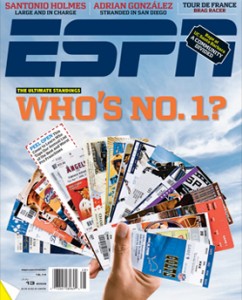
In the economic times of 2009 everyone is trying to define and produce value. Like most marketing buzzwords, value can be a very ambiguous concept.
When fans look to spend their discretionary income to take in a ballgame, they base their purchasing decision on the emotions that the product of sports provides. The emotional aspect in purchasing the experience can at make fans even more discretionary.
Fans are seeking the best deals to see their favorite teams and teams are consistently trying to add value to the fan experience. Fans want deals, but buy value. However, while teams often sell by adding value, fans buy based on their perceived value. ESPN’s recent Ultimate Standings survey encompasses eight categories that relate to the fan’s perception of value. The objective of the survey being to measure nationally how well teams turn fan dollars into wins.
There is a paradox in this measurement. First, the poll was created based on what fans want, not what they consume. Second, it was only 50,000 plus responses, while by July 6th over 16.1 million fans had already consumed an American League baseball game in 2009. For comparing 122 teams business operations across 4 leagues, dozens of markets, and two countries it’s very functional. It does much less for helping the 122 teams in their markets with their fans. As I mentioned, their survey was created based on what fans want, not what they buy. Most products, tangible or intangible, the margin of what consumers want and what they buy is to great to successfully market on that information alone (for a great book on what consumers want vs. what they buy, pick up Buy-ology by Martin Lindstrom).
With the diverse market segments from which these teams reside, the margin in their fans perception can be just as diverse. To help close this marginally gap, teams rely on their sales staffs to reduce that margin in perception and boost attendance.
 In seeking long term success in these markets it is best to concentrate on the local perceived value than what the teams are doing nationally. Doing so can only help narrow the margin in both the value being added and the value being perceived, translating into sales and hopefully championships.
In seeking long term success in these markets it is best to concentrate on the local perceived value than what the teams are doing nationally. Doing so can only help narrow the margin in both the value being added and the value being perceived, translating into sales and hopefully championships.
I’ve always worked under the philosophy that there are no problems, only opportunities. I couldn’t think of a better mantra for the economic times of 2009. Teams this year are being provided with more opportunities, which typically and initially disguise themselves as problems. It is in these opportunities that teams can learn to better understand our fans’ perceptions. If we can continue to reduce the marginal difference between the perceived value and the value being added, teams will be the reality and the fans will be closer to the game!
Photo Credits: Convention Fans



Comment below
let us know your thoughts